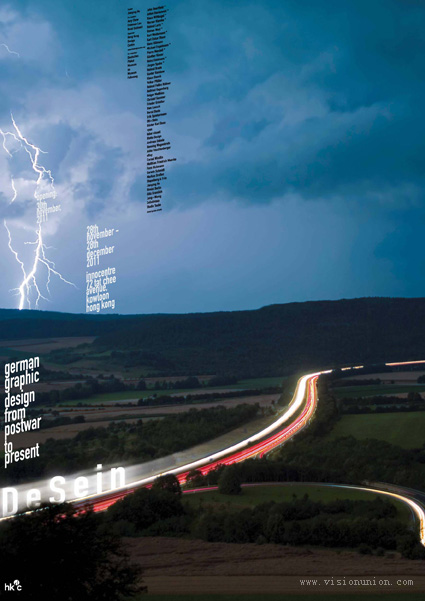|

“De Sein: 从战后到现代德国平面设计”这个展览,展示第二次世界大战至今的德国平面设计发展,从海报、书籍、文字及企业形象设计等几个方面,来展示德国在历经冷战、墙倒和两个德国统一后至今的平面设计历程。该展览部分展品来自德国海报博物馆Volkwang博物馆的收藏,其余作品皆来自设计师本人的支持。
The exhibition “De Sein - German Graphic Design from Postwar to Present” is held between 28th November 2011 to 28th December 2011 in InnoCentre.
“De Sein: 从战后到现代德国平面设计”
于11月28日至12月28日在香港创新中心展出
Opening Ceremony: 6-7:00pm, 30th November, 2011
Guests of Honour: Rene Gorhnert, Dr. Christian Bauer
开幕式: 2011年11月30日下午6-7点,香港创新中心
开幕式嘉宾演讲:Rene Gorhnert, Dr. Christian Bauer
Venue地点
InnoCentre, 72 Tat Chee Avenue,
Kowloon Tong, Hong Kong
Curator策展人
Jianping He何见平
Co-curators联合策展人
Amy Chow, Freeman Lau, René Grohnert
周婉美,刘小康,René Grohnert
Organiser主办
Hong Kong Design Centre
香港设计中心
www.hkdesigncentre.org
Co-organiser协办
Deutsches Plakat Museum im Museum Folkwang
德国Folkwang博物馆之海报博物馆
Catalogue published in 2011 by
hesign (Publishing & Design)
发行图书一册由hesign出版
Editor主编
Jianping He何见平
Design & Layout设计
hesign Berlin
前言
Preface
存在中的德国平面设计
香港设计中心今年借“设计营商周”之际,邀请我策划一个有关现代德国平面设计的展览。“营商周”是香港政府资助活动,旨在扶持设计和商业效应的快速发酵,进而为社会产业链带来更多的能量。我一直欣赏香港,在设计上遵循商业为中心,以发挥商业的能量而间接激发设计的发展。在这点上,香港和德国不一样,香港更能不受设计史、艺术史、本土文化等因素的束缚,在设计创作上发挥了更大的包容性,这种包容的力量,令香港以商业为核心从而形成自我的文化沈淀。
在香港平面设计界,既有靳埭强先生这样以水墨、书法为表现手段,受到中国传统绘画,人文思想影响的设计作品;也有陈幼坚先生这样融汇中西(也有深厚的日本文化理解)大量设计作品;还有象石汉瑞这样,以西方文化为核心思想的设计。请注意,这三种不同的风格是同时并存的,这是香港的特色,也是魅力。石汉瑞曾喻为“跨文化设计”,这种跨文化的威力巨大,它带来了社会繁荣和商业的长足发展。
它不同于德国平面设计。德国平面设计,可以按时间为线索,分得清清楚楚,就如战后的乌尔姆造型学院后是汉斯·赫尔曼引导的卡塞尔学院;然后是金特·凯泽, 冈特· 兰堡 , 霍尔格·马蒂斯, 佛瑞德· 格林蒂乐这些为代表的摄影蒙太奇手法的设计风格;乌韦·勒斯的Typo风格;墙倒以后的王翰尼的插图风格和cyan的字体编排风格等可以作为典型。
第二个特点,德国平面设计可以清晰地区分CI/信息设计和海报/书籍设计两个脉络,前者更多实际商业案例,后者更多文化范畴的工作。奥托·爱舍,安东·斯坦科斯基, 库尔特·魏得曼和埃里克·施比克曼无疑是前者,赫尔曼, 凯泽, 兰堡, 马蒂斯, 勒斯和cyan等则将大部分工作精力投入在文化活动的海报设计上。当然也不是那么绝对的,比如皮尔·门德尔,除了他大量图形语言精炼的海报佳作外,也设计过大量如“IF”,“SIEMENS”等标志。
德国设计不同于香港的第三个特点是学院派特色,德国知名设计师除了受到大学专业教育外,又几乎全部任教于大学。大学教授在德国是一个得到社会普遍尊重的工作,大学教授也是公务员,教职终身制。虽然它的报酬只是香港教授的三分之一,但在香港,知名设计师,最多只是客场任教大学。忙碌的专业工作,也不允许投入大学授课这第二份工作。设计教育和实践结合,似乎在德国更被看重一些。
“De Sein”这个展览,我一开始,就想以哲学思考作为主轴,我把时间圈定在“战后到现代的德国平面设计”上,为的是和香港能有一些时间上对比,更具象表现德国现代平面设计。在设计作品类型上,也包涵CI、信息设计、海报和书籍设计三个大部分。这些作品更多按德国设计历史的时间为组成元素,它们其实是时代发展的见证。“De Sein”受惠于“Da Sein”(存在主义),发音更接近“Design”。“一切存在的都有存在的理由”,事实上,德国平面设计不但只是存在,它对世界的影响又是那么巨大的,它符合现代简约主义审美的需求,也符合机器大生产的功能性,它存在着并发展着。
我总把德国设计想象成德国高速上的速度,作为唯一高速不限速的国家,速度的形成必须有高质量的车和道路建设,外加冷静的驾驶头脑。事实上,德国平面设计在一战后二战前,就以“制造联盟”,“青年风格”和“包豪斯”影响世界,当然“包豪斯”的全球影响是最深远的。
风驰电掣的时代,全球化的科技,不知设计将驶向何处。
何见平
De Sein – To be German
In this year‘s Business of Design Week, I was invited by the Hong Kong Design Center to curate an exhibition about contemporary German graphic design. BODW is a Hong Kong government-funded activity, aims to support the rapid fermentation between design and business, and thus to bring more energy into the society‘s production chain. I‘ve always been appreciating Hong Kong, with it‘s business centered design industry, and the way it‘s business power indirectly stimulate the development of design. The difference between Hong Kong and German design is, Hong Kong designers can work without the constraints of several factors like design history, art history and local culture, indeed the power of its inclusiveness in not only facilitate the creativity of design, it allows Hong Kong, having business as it‘s core, to precipitate it‘s own culture.
In the Hong Kong graphic design industry, we see the works of Mr. Kan Tai Keung, using ink and calligraphy as methodologies, working under the influence of chinese traditional painting and it‘s cultural ideologies; the works of Mr. Alan Chan, integrating east and west, with a profound understanding of japanese culture; we have designers which utilize the core values in western culture like Mr. Henry Steiner. Noted that these three completely different styles exist side by side, this is the characteristic, or I should say, the charisma of design from Hong Kong. Mr. Henry Steiner once called this as “cross-cultural design”, with an impact that brings great prosperity to the society and long-term development in business.
It is different from German graphic design. The first characteristic of German graphic design is, one can trace back its clearly defined history according to the timeline, such as Ulm school in the postwar period, then the Kassel School guided by Hans Hillmann; and then Kieser, Rambow, Matthies and Grindler, which are the representatives of designers using photographic montage; Typo style of Uwe Loesch; after the fall of the berlin wall there came the illustrative style of Henning Wagenbreth and typesetting style of cyan.
The second characteristic is, German graphic design can be clearly defined into two aspects such as corporate identity/information design and poster/publication design, with actual business cases and works in the cultural genre respectively. Otl Aicher, Anton Stankowski, Kurt Wiedemann and Erik Spiekermann are great examples of CI and information design; Hillmann, Kieser, Rambow, Matthies, Loesch and cyan put most of their time in posters for cultural events. Of course it‘s not that absolute, for instance Pierre Mendell, besides a lot of his poster masterpieces with refined graphics and text, he also designed a large number of logos such as logos of “IF” and “SIEMENS”.
The third characteristic which differentiate German graphic designs from Hong Kong‘s is it‘s academy characteristics, famous German designers were not only under professional university education, most of them are now teaching in universities.Being a professor is a respected career in the German society, university professors are civil servants with life tenure, although they are only receiving one third of remuneration comparing with Hong Kong professors. Indeed, famous Hong Kong designers are mostly teaching in universities as guests, their busy schedule discourage them from devoting into lecturing as a second job. Seemingly the integration of design education and practice is being more valued in Germany.
About the exhibition “De Sein”, I started by using philosophical concepts as a spindle, then I defined the period as “postwar to present”, as to create a time comparison with Hong Kong, and to concretely express contemporary German graphic design. The types of works are CI, information design, poster and publication design. These works are composited by the timeline of German design history, witnessing it‘s development. “De Sein” is under the idea of “Da Sein”(existentialism), indeed it‘s pronounced like design, “everything that exists has it‘s cause”, in fact, German graphic design not only exists, but having a huge impact on the world, it meets the demands of modern minimalistic aesthetics, fitting the functionality of mass production, as a developing being.
I always imagine German design as the speed limit of the motorway, Germany, as the only country with no general motorway speed limit, the only way of making a high speed possible is the combination of high quality vehicles and road infrastructures, indeed a calm driver‘s mind. In fact, after the first world war German graphic design was already influencing the world by “Werkbund”, “Jugendstil” and “Bauhaus”, indeed “Bauhaus” had the most far-reaching global impact.
In this century of unstoppable speed, technology and globalization, I wonder how far design could go.
Jianping He
|